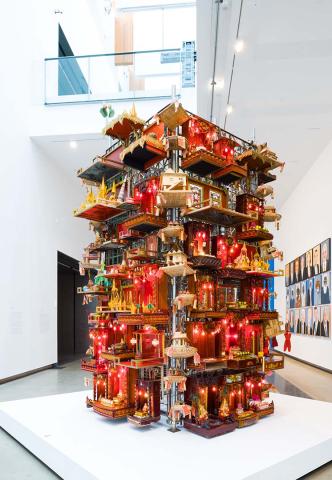Lyno Vuth: House – Spirit 2018
By Tarun Nagesh
The 9th Asia Pacific Triennial of Contemporary Art November 2018
The iconic White Building formerly stood in the heart of central Phnom Penh.1 Home to a diverse community of more than 2000 residents, it was a vibrant hub for artists, musicians, performers and craftspeople, and internationally acclaimed as a unique example of modern South-East Asian architecture. As part of artist collective Stiev Selapak, Vuth Lyno worked closely with the community of the building until its demolition by a foreign developer in 2017.
Inaugurated in 1963 during the post-independence period, the White Building was reminiscent of Le Corbusier’s utopian vision. Comprising 468 residences, it represented modern urban living in the form of affordable, multistorey apartments for Cambodians at an optimistic time. In April 1975, however, almost all of the 2.5 million residents of Phnom Penh were evacuated, following the surrender of the Cambodian government to the Khmer Rouge. The reopening of the city in 1979 saw a return migration under very different circumstances. Communities that had been dispersed for years were very slowly rebuilt. The White Building was reoccupied first by the few surviving artists, and then by newcomers from around the country. It drew a wide group of creatives, families and ethnicities, together with small businesses and restaurants, as well as places for education and socialising on street-level. Both the building and its community became subjects for local artists, and it attracted attention from art and architecture enthusiasts around the world.2 An icon of Phnom Penh and symbolic of the rebuilding of community in the aftermath of the Khmer Rouge era, the demolition of the White Building now represents yet another erasure in Cambodian social history.
Vuth is deeply engaged with the subjects of social transformation, community relationships and urban development in Cambodia, and his towering sculpture House – Spirit 2018 stands as a testament to the White Building and its communities. Over time, he had forged close relationships with the community, and as residents left their homes, he collected the spirit houses that were abandoned or offered to him.3 Common throughout South-East Asia, spirit houses are domestic temples or shrines that are worshipped to appease the sprits; in return, homes and businesses are protected from harm. The designs vary greatly from the highly decorative to simple bamboo structures representing regional styles and religious influences. The White Building contained a great diversity of spirit houses — regional styles from rural Khmer communities, as well as combinations of the mixed ancestries that coexisted in the building, many revealing fusions between animist and Buddhist beliefs.
A tower of more than 80 shrines, House – Spirit recalls one of the modular columns of apartments and balconies that comprised the building. Together, these shrines represent the diverse community of the White Building, and the belief systems that transcended the fraught history of the city. For Vuth, they embody the collective memory of the building:
. . . the spirits have accumulated history and stories of the community and the neighbourhood. The spirits knew the anxieties and desires of the community, collected the stories and witnessed what happened in the neighbourhood. They are the archive or bank of knowledge, though paradoxically are inaccessible, safeguarded, and remain private.4
House – Spirit expresses Vuth Lyno’s profound connection to the community — one where he had built friendships, recorded histories, learnt about its spiritualities, and fought for its survival. Importantly, the work also preserves a memory of one of Cambodia’s best-known communities, capturing a hybrid social system built on diversity, community and resilience. Tarun Nagesh
Endnotes
- The White Building was overseen by state architect Vann Molyvann and designed by Cambodian architect Lu Ban Hap and French–Russian architect Vladimir Bodiansky. It was conceived as part of the ambitious Bassac Riverfront Project, a public complex built on reclaimed land.
- Established by the Stiev Selapak artist collective in 2010, Sa Sa Art Projects housed a residency, archival space and regular educational workshops from 2010 to 2017. It has now reopened in another part of Phnom Penh; for their archive, see White Building, White Building, viewed June 2018.
- Spirit houses generally belongto a specific dwelling, and so new ones would be required when the residents resettled.
- Vuth Lyno, email to the author, 25 January 2018.
Connected objects

House - Spirit 2018
- VUTH, Lyno - Creator